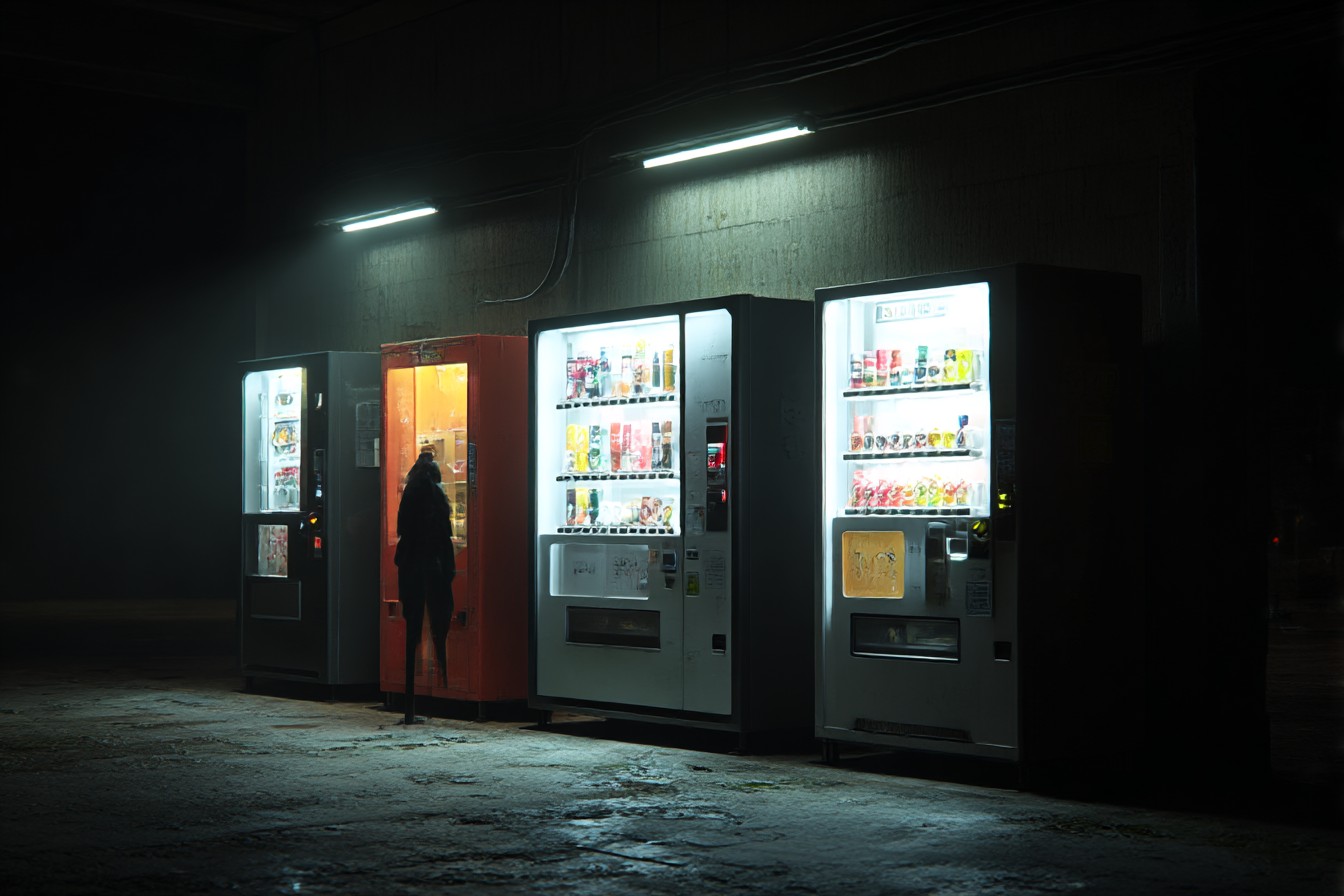I’ve always considered myself reasonably tech-savvy. I mean, I’ve got the usual apps, I can troubleshoot my mum’s Wi-Fi over the phone, and I even set up my own smart home system without wanting to throw my router out the window… more than twice. But there are moments when I encounter something so needlessly complicated, so absurdly over-engineered, that I wonder if we’ve collectively lost the plot.
Last Tuesday was one such moment.
I was rushing between meetings in the city centre, desperately needing a caffeine hit to survive the afternoon. Spotting a sleek new vending machine in the corner of an office building lobby, I made a beeline for it. The thing was gorgeous, I’ll give it that – all curved edges, matte black finish, and a touchscreen that probably had more computing power than the equipment that guided Apollo 11 to the moon.
“Brilliant,” I thought, fishing around in my pocket for a couple of quid. That’s when I noticed something odd – there was no coin slot. No card reader either. Just a QR code glowing on the screen with the words “Scan to pay with crypto.”
Crypto? For a bloody Diet Coke?
I stood there, genuinely baffled, as a small queue formed behind me. I scanned the machine’s façade again, thinking surely there must be some alternative payment option tucked away somewhere. Nope. This vending machine accepted cryptocurrency exclusively.
“You need to set up a wallet,” offered a helpful twenty-something behind me, looking at me with the gentle pity usually reserved for grandparents struggling with FaceTime. “It’s actually really easy.”
Easy? Easy would be inserting a pound coin like humans have done with vending machines since approximately forever. Easy would be tapping my debit card. This was the exact opposite of easy.
“I’ve just got five minutes before my next meeting,” I explained, already backing away. “I just wanted a quick drink.”
“It only takes about 20 minutes to set up an account,” he said, completely missing the point. “Plus maybe a day or two for verification.”
A day or two. For a vending machine.
I left, caffeine-less and increasingly irritated, and found a corner shop where I bought a Coke with actual money in under 30 seconds.
This encounter sent me down a rabbit hole. Were crypto vending machines becoming a thing? Why would anyone think this was a good idea? Who exactly was the target market here?
Turns out, these machines are popping up everywhere – university campuses, tech company offices, trendy shopping centres, and co-working spaces. They’re marketed as “forward-thinking convenience solutions for the digital native.” Which seems like a grandiose way of saying “needlessly complicated drink dispensers for people with too much time on their hands.”
I called my mate Charlie, who’s been boring me senseless about cryptocurrency since 2017. “Oh yeah,” he said, with inappropriate enthusiasm. “They’re brilliant. Completely cuts out the middleman.”
“What middleman?” I asked. “It’s a vending machine. The only people involved are me and whoever stocks it with Twixes.”
“The banking system,” he replied, as if explaining something obvious to a child. “Transaction fees. Currency conversion. Government oversight.”
I held the phone away from my ear for a moment to process this. “Charlie,” I said slowly, “it’s a Diet Coke. It costs £1.50. I’m not laundering diamonds here.”
“It’s about the principle,” he insisted. “Plus, some of these machines give you discounts if you use their preferred coins.”
Ah, there it was. These weren’t just vending machines; they were crypto marketing tools.
My curiosity piqued, I decided to go all-in on the experiment. I spent a ridiculous three hours one evening setting up a crypto wallet, verifying my identity (which involved more documentation than my mortgage application), and purchasing a small amount of Ethereum. All this to buy a packet of crisps from a vending machine.
Two days later, wallet loaded and phone in hand, I returned to the scene of my initial defeat. The crypto vending machine stood there, smug in its supposed innovation. I scanned the QR code, opened my wallet app, and initiated the transaction.
And waited.
And waited.
“Network congestion,” my app helpfully informed me. “Estimated completion time: 25 minutes.”
Twenty-five minutes. For a packet of crisps that should take 10 seconds to purchase.
The bloke who came to refill the machine found me sitting on the floor next to it, staring blankly at my phone. “First time?” he asked with a knowing smile.
“Is it always this slow?” I asked.
“Oh, this is actually pretty good,” he replied. “Sometimes during high traffic periods, it can take hours.”
Hours. HOURS.
“Why would anyone use this?” I asked, genuinely baffled.
He shrugged. “Novelty, mostly. The company that makes these is trying to ‘normalize crypto for everyday transactions.’ Plus the building management thought it sounded cool in their promotional materials.”
There it was – style over substance, the triumph of seeming innovative rather than actually being convenient.
When my transaction finally went through – a full 37 minutes after initiation – I was rewarded with a bag of Walkers that had probably been sitting in that machine since the Queen’s Jubilee. The experience had cost me approximately £2.75 in crisps, £4 in network fees, and just under four hours of my life I’ll never get back.
The next day, I noticed something else about my crypto vending machine adventure – the value of Ethereum had dropped overnight, meaning my £20 of crypto was now worth about £17.50. So my bag of stale crisps had effectively cost me £9.25.
What a bargain.
The whole experience reminded me of something my grandfather used to say: “Just because you can, doesn’t mean you should.” Sure, we can put blockchain technology into vending machines. We can make buying a chocolate bar as complicated as international banking. But why? What problem is this solving?
It’s part of a broader trend I’ve noticed – technology being shoehorned into places it doesn’t belong, making simple things needlessly complex. Like those restaurants that have replaced menus with QR codes, leaving you squinting at your phone instead of having a normal conversation. Or the smart fridge that sends you notifications about your milk expiration date, as if sniffing it wasn’t a perfectly functional system for thousands of years.
I mentioned my crypto vending machine saga at a dinner party last weekend, expecting everyone to share my frustration at this technological overreach. Instead, my friend Priya looked up excitedly.
“Oh, you should see the one in our office! It accepts NFTs as payment!”
I nearly choked on my wine. “NFTs? For what?”
“Mostly sandwiches and salads,” she replied. “But here’s the cool part – each purchase gives you a unique digital token that builds up to form a digital art collection.”
“So… a loyalty card?” I asked. “But more complicated and environmentally damaging?”
She considered this for a moment. “Yeah, I guess. But it’s, you know, blockchain.”
And therein lies the problem. “Because blockchain” has become a justification for overcomplicating just about anything. It’s not enough for a system to be efficient, convenient, or user-friendly – it has to be “disruptive” and “revolutionary,” even if that means taking a 10-second transaction and turning it into a multi-day ordeal.
Don’t get me wrong – I’m not anti-technology. I appreciate innovation when it genuinely improves our lives. Online banking? Brilliant. GPS navigation? Lifesaver. Streaming services? Game-changer. But a vending machine that requires a digital wallet, network fees, and the patience of a saint just to dispense a Twix? That’s not innovation – it’s complication for complication’s sake.
Last week, I spotted another crypto-only vending machine in a shopping centre. Next to it stood a regular vending machine – the kind where you insert coins or tap your card and immediately receive your chosen snack. I watched for twenty minutes (I was waiting for my partner who can spend approximately forever in Zara). In that time, seven people used the traditional machine. The crypto machine stood untouched, its screen occasionally changing to display different cryptocurrencies it accepted, like a digital peacock flashing its feathers to an unimpressed audience.
Sometimes, the old ways are old for a reason – because they work. They’re efficient, accessible, and don’t require a tutorial. There’s a certain irony in the fact that technology meant to democratize finance has created a vending machine that’s effectively unusable for 99% of the population.
So if you’re considering implementing cryptocurrency as the only payment option for something, I beg you – ask yourself one question: “Is this actually better, or just different?” Because if your innovative solution takes longer, costs more, and excludes most potential users, then maybe – just maybe – it’s not actually an improvement.
Now if you’ll excuse me, I’m off to buy a Snickers. With coins. Like a caveman.













